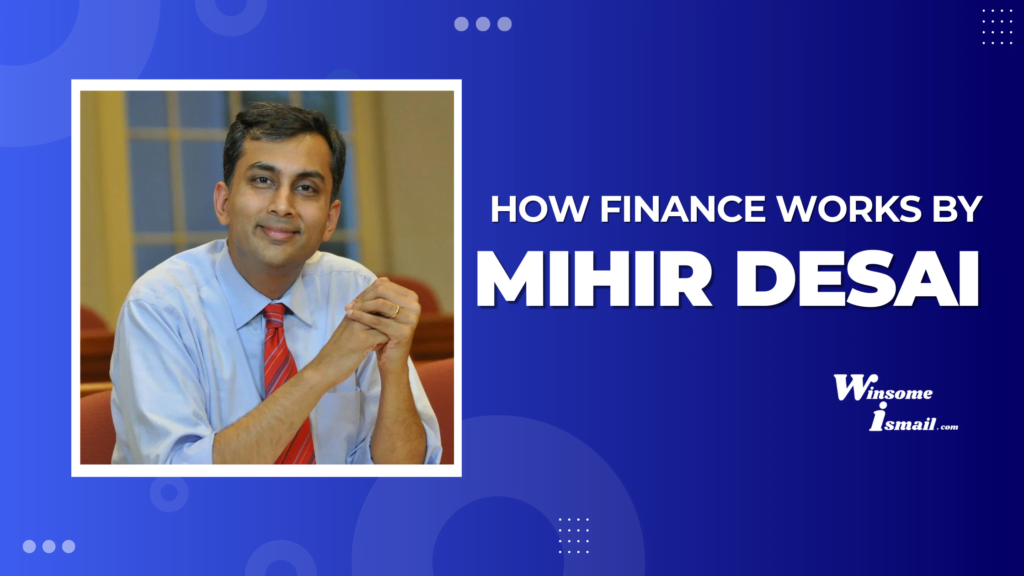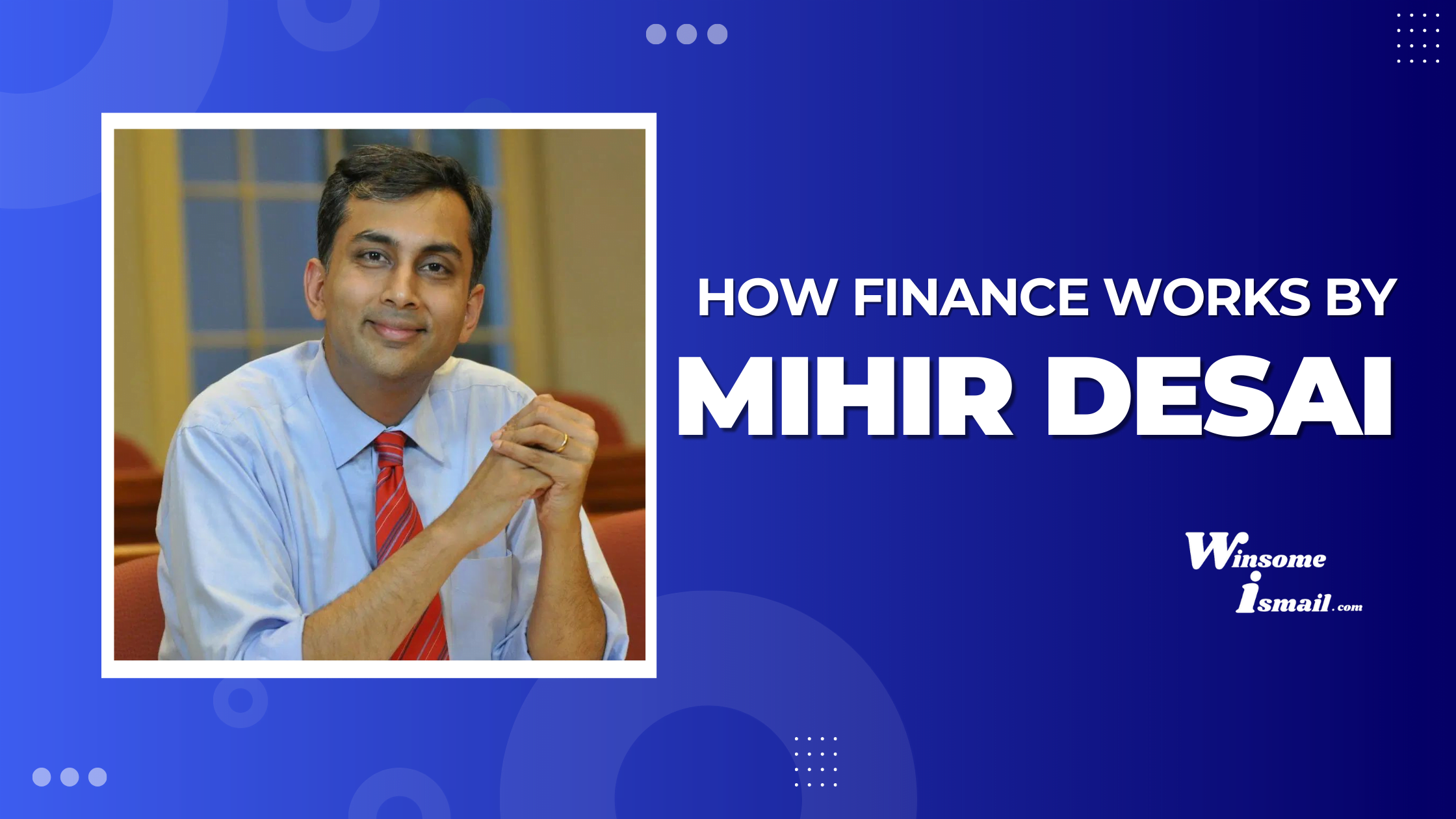
In this article, we are going to discuss How Finance Works by Mihir Desai. Mihir Desai is a well-known author and writer of How finance works, The Wisdom of Finance. Also featured on Bloomberg radio. His full name is Mihir A Desai. He is a financial group professor of finance. Desai teaches finance at Harvard Business School as the Mizuho Financial Group Professor.
About the author
Mihir Desai is a well-known Indian Human rights lawyer. He deals with cases that violate one’s freedom and rights. Some of his prominent cases deal with masquerades, riots, fake encounters by police, women’s safety, lack of freedom of speech, and many more brutal events. He is a faculty of Harvard University, A Master of Finance and of risk and return.
Mihir Desai is not only a lawyer, and professor but also a great author. His books have a positive impact on students and readers. His description of topics is easier to understand and store in the brain. His simplified theories and concepts bring huge changes in one’s view on several topics. His perspective on solving problems helps in getting answers in a better and faster way. His books also play a huge role in maintaining good relations with the core department of a company like shareholders and stack holders.
Mihir Desai net worth
Mihir A Desai was born on July 9, 1967, in India. He is a famous economist and human rights lawyer as of January 9, 2023 his net worth is $5 million.
Overview
This book helps in changing one’s view on finance. Hearing this word itself, makes us go through a rollercoaster of emotion. This emotion makes us feel a loss of courage or self-confidence. The two things which are required to understand this book are curiosity and perseverance. This book (How Finance Works: The HBR Guide to Thinking Smart About the Numbers) is not specific to a particular group of finance students. It can be read by everyone who has a keen interest in finance and hopes to increase their depth of knowledge about finance by Mihir Desai.
Chapter 1: Financial Analysis (Using ratios to analyze performance all while playing a game)
This chapter begins with a game that introduces the world of finance. In financial analysis, performance is the key. It gives solutions to major problems and questions asked by financial professors from CFOs, investors, and bankers. It provides insight into the company’s performance, scope, possibility, and potential.
Financial analysis is different from accounting. Here we deal with number ratios which are useful in accounting rather that the core concepts of accounting like debits and credits. By comparing the ratios we can find the reason for the critical concept that is performance. Here we can find how industries perform by using ratios.
People Also Read: What Is Working Capital?
Chapter 2: The finance perspective (Why Finance is Obsessed with Cash and the Future)
As discussed earlier the statements of accounting play a pivotal role in finance but have their own drawbacks. To improve on these drawbacks, the finance field has different approaches regarding decisions, solutions, and settlement of performance.
This perspective has two important pillars:
- Converting cash to get better economic returns
Here several financial practitioners are being curious to find ways that increase cash. Sometimes even obsessed with cash. Finding solutions to problems that hinder the conversion of cash to economic returns. Cash doesn’t just deal with money. There are three types of cash EBITDA (earnings before interest, taxes, debt, and amortization), operating cash flow, and free cash flow. Free cash flow plays the protagonist’s role.
- Future and forward-looking.
The future preys on the financial practitioner’s mind. Thinking of the future comes in the first place when thinking about finance. One should have a proper understanding of how events turn out in the future. Probability of the future outcomes should be running in one’s mind.
Here most valuable questions of high value in finance come into the picture.
Chapter 3: The financial ecosystem (Understanding the Who, why, and How of capital markets)
An ecosystem is a region where different realms coexist. The financial ecosystem means the people who are responsible for different aspects of the finance department. It mainly consists of managers, stakeholders, shareholders, and others who affect the finance of a company. At this point in time, we dig into the role of finance in society and markets. Check if its role is accelerating or decelerating. If it is decelerating then make changes to construct its position. Discover the possibilities of money using finance. Here we get introduced to capital markets which are the main source of money for finance. Capital markets are private organizations that affect the economy of a nation.
Chapter 4: Sources of value creation (Risk, costly capital, and the Origins of Value)
In Chapter 1, we got knowledge about “create”. This word plays a key role in performance. As Luna Lovegood once quoted that “Being different isn’t a bad thing. It means you are brave enough to be yourself.” Being unique and different is a prerequisite to stand out in this competitive world. The two special terms value construction and value destruction are explained in this chapter. The importance of being elite has been explained by giving some examples.
- Apple products: an example of value construction
We know that Apple is famous all over the world and its craze is never-ending. Its products have huge market value. Initially, for a long period of time, Apple products had a stable market but their performance slowly fell in the early 2000s. Other companies like IBM, and Microsoft were leading in terms of value creation. Later in the mid-2000s, Apple’s value creation surpassed IBM and Microsoft.
This major change was due to its new value creation policy. This policy included launching new Apple products from smart watches, iPad, iPhones, etc.
- Avon products: an example of value destruction.
Avon was a leading cosmetic brand with high economic returns. It had a high value during its initial days. It was overvalued for most years but it eventually fell for its overpricing and lack of new value-creation methods. Eventually, even the Avon members came to know about the overpricing in the place of true value paved the way for their failure.
People Also Read: Two Best Demat Trading Platforms For Trading Stocks, Equity And Commodities
Chapter 5: The Art and Science of Valuation (How to Value a Home, an Education, a Project, or a Company)
In order to invest in something, that can be education, company, real estate, business, or even buying a house. We make sure that we are on the right track by asking several questions. These questions are part of the art and science of valuation. Asking the right questions is key to solving any problem. Wisdom of finance discovering humanity.
Some valid questions may be,
- Am I making the right move?
- Am I on the right path?
- Am I on the profit side?
- Is my money put to the right use?
- Am I being benefited?
- What are the pros and cons of investment?
- How much should I pay?
- Can I pay the amount?
- Is the amount feasible?
- Do I get rewards?
In the previous chapter, we get to know that value is created when there is a correlation between risk and economic return. Value of cash and free cash flow In this chapter we focus on bringing methods for proper valuation. A realization of valuation as an art and not a Science. More subjectivity is an art form using Science. It may or may not give the right answers always it might also result in ambiguous answers which may not satisfy you. Though it is ambiguous it plays a principal role at the end point. Making it a main point of notice.
Chapter 6: Capital allocation (How to make the most important decisions facing CEOs and CFOs)
In this chapter, we come across the core members of a company like the CEOs and CFOs. Their decision affects the life of a company. Growth either on the positive or negative side is solely dependent on the core department consisting of CEOs and CFOs. Hence it is important for them to take the right decision and move on the right way. Though these CEOs and CFOs have members who provide assistance with problems overall it is his or her choice that rules the company.
Capital allocation has been explained with the example of Alphabet aka Google and Apple
Apple’s shareholders were revolting against Tim Cook for irregular distribution of cash. This revolt subsided as Apple released this cash to its shareholders. Alphabet took this as a lesson and started giving its shareholders money even before the members started an argument. Finance with Harvard professor Mihir.
Conclusion
This book plays a vital role in bringing a change in one’s view on finance. It gives broader knowledge about the key factors that affect the growth of the company. To prevent future challenges and to increase the cash flow and performance of the company. All the above about discussed by Mihir Desai.
People Also Read: MNC Companies Interview Questions For B.Com, MBA, CA, IPCC, PGDM Students
Here is the book written by mihir desai


Hello! I’m Ismail, founder and author of WinsomeIsmail.com.
With an MBA and a strong passion for sharing knowledge, I create informative, value-driven content across multiple niches, including Blogging, Finance, SEO, Technology, and Career Development.
“Happiest are those who do the most for others.”
Feel free to explore my articles, and let’s connect!
